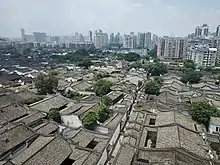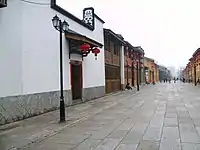Sanfang Qixiang
Sanfang Qixiang (Chinese: 三坊七巷; pinyin: sān fāng qī xiàng; Foochow Romanized: Săng-huŏng-chék-háe̤ng), literally Three Lanes and Seven Alleys, is a historic and cultural area in the city of Fuzhou. Its name is derived from the three lanes of Yijin (衣锦), Wenru (文儒), and Guanglu (光禄) and the seven alleys of Yangqiao (杨桥), Langguan (郎官), Ta (塔), Huang (黄), Anmin (安民), Gong (宫), Jipi (吉庇). Covering a total area of 0.38 square kilometers (0.15 sq mi), it is celebrated as an architectural museum of Ming and Qing Dynasty buildings, including numerous National Designated Monuments like the historic residences of Yan Fu, Lin Congyi, Bing Xin and Lin Juemin. Because of its more than 400 rich, famous and powerful residents, this port city was known as 'Beverly Hills' of imperial China.[1] Thanks to its fame as a living fossil of traditional Chinese urban wards of Li (里) and Fang (坊) that date back to as early as Tang Dynasty, it was inscribed on the UNESCO World Heritage Tentative List in 2013,[2] and later designated a National Historic and Cultural Street by the Ministry of Housing and Urban-Rural Development and State Administration of Cultural Heritage in 2015.[3] Owing to the extraordinary efforts to protect the historic fabrics from Sanfang Qixiang Administration,[4] it was awarded an honorable mention of the 2015 UNESCO Asia-Pacific Heritage Awards.[5]


Sanfang Qixiang is one of the most famous attractions. There are thousands of tourists visit there since it is the standard of Fuzhou. One of the reason why Sanfang Qixiang is so famous is that there are a lot of celebrities. One of the most famous one is Lin Zexu , Yanfu.
Lin Zexu "The first person to see the world with his eyes open", August 30, 1785 (the 50th year of Qianlong) ~ November 22, 1850 (the 30th year of Daoguang), Han nationality, Fujian Houguan (now in the suburbs of Fuzhou, Fujian Province) , The character Fu, Shao Mu, Shi Lin, the evening name of the old man in Tucun, the old man in Tucun, the old man in Qiyuefeng, the old man in Pingquan, and the scattered people in Lishe. Politicians, thinkers, and poets in the late Qing Dynasty were great national heroes in the process of resisting external humiliation for the Chinese nation. Guanzhiyipin, former governor of Jiangsu, Governor of Guangdong, Guangdong, Governor of Huguang, Governor of Shaanxi, Gansu, and Governor of Yungui. He was appointed as minister of imperial commission twice; because of his advocacy of prohibiting opium, resisting Western aggression, and insisting on safeguarding China’s sovereignty and national interests, he was deeply affected. The admiration of the Chinese in the world. He conforms to the trend of historical development, and adopts an attitude of actively understanding and absorbing the achievements of Western civilization and using them for me. Therefore, he can become "the first person to see the world with open eyes and the pioneer of learning advanced technology from the West." There is Lin Zexu's ancestral hall on Macau Road next to Sanfang Qixiang.
Yanfu Yan Fu (1854.1.8—1921.10.27) was originally named Zong Guang, with the character Youling, later renamed Fu, with a few words, of the Han nationality, Fujian Houguan, is a very influential bourgeois enlightenment thinker, translator and educator at the end of the Qing Dynasty. One of the "advanced Chinese" who sought truth from Western countries in history. Yan Fu was born in a family of doctors. In 1866, Yan Fu was admitted to the Fuzhou Shipping School in his hometown to learn English and modern natural science knowledge. Five years later, he graduated with honors. From 1877 to 1879, Yan Fu and others were sent by the public to study in the UK. He first entered Portsmouth University and then transferred to the Greenwich Naval Academy. During his study abroad, Yan Fu became interested in British society and politics, involved in a large number of bourgeois political academic theories, and especially admired Darwin's theory of evolution.
References
- CNN, "Fuzhou's Sanfang Qixiang: The 'Beverly Hills' of imperial China", 1 November 2017.
- UNESCO World Heritage Center, "SanFangQiXiang", Retrieved on 10 October 2015
- Ministry of Housing and Urban-Rural Development, "住房城乡建设部 国家文物局于公布第一批中国历史文化街区的通知", 3 April 2015. Retrieved on 3 April 2015.
- Sanfang Qixiang Administration, "三坊七巷管理委员会", Retrieved on 10 October 2015
- UNESCO Bangkok. "2015 UNESCO Asia-Pacific Heritage Awards Winners Announced", 1 September 2015. Retrieved on 1 September 2015.